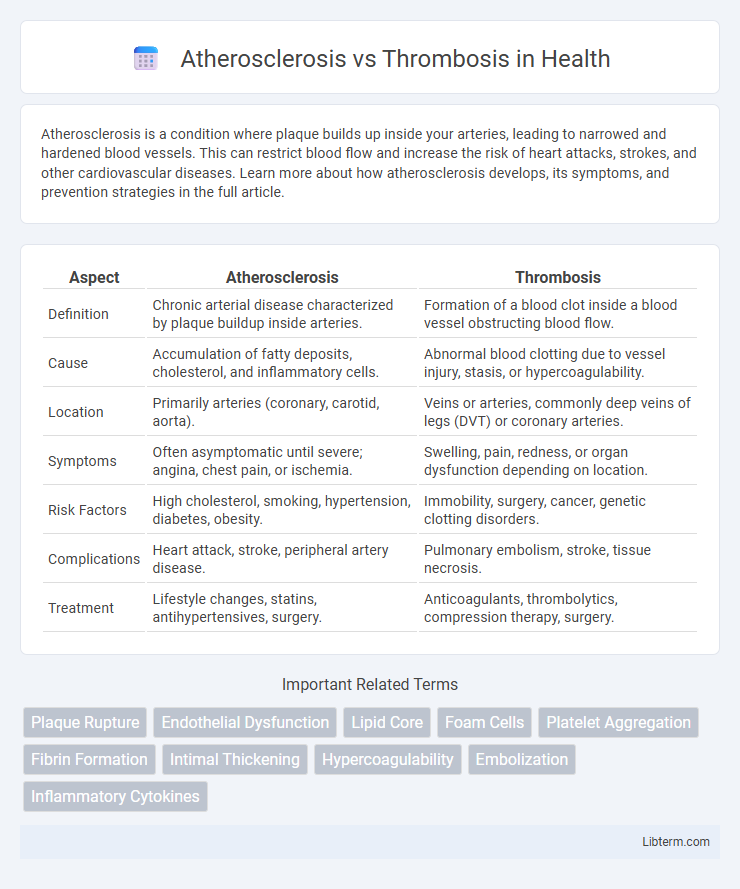Atherosclerosis is a condition where plaque builds up inside your arteries, leading to narrowed and hardened blood vessels. This can restrict blood flow and increase the risk of heart attacks, strokes, and other cardiovascular diseases. Learn more about how atherosclerosis develops, its symptoms, and prevention strategies in the full article.
Table of Comparison
| Aspect | Atherosclerosis | Thrombosis |
|---|---|---|
| Definition | Chronic arterial disease characterized by plaque buildup inside arteries. | Formation of a blood clot inside a blood vessel obstructing blood flow. |
| Cause | Accumulation of fatty deposits, cholesterol, and inflammatory cells. | Abnormal blood clotting due to vessel injury, stasis, or hypercoagulability. |
| Location | Primarily arteries (coronary, carotid, aorta). | Veins or arteries, commonly deep veins of legs (DVT) or coronary arteries. |
| Symptoms | Often asymptomatic until severe; angina, chest pain, or ischemia. | Swelling, pain, redness, or organ dysfunction depending on location. |
| Risk Factors | High cholesterol, smoking, hypertension, diabetes, obesity. | Immobility, surgery, cancer, genetic clotting disorders. |
| Complications | Heart attack, stroke, peripheral artery disease. | Pulmonary embolism, stroke, tissue necrosis. |
| Treatment | Lifestyle changes, statins, antihypertensives, surgery. | Anticoagulants, thrombolytics, compression therapy, surgery. |
Understanding Atherosclerosis: Definition and Causes
Atherosclerosis is a chronic condition characterized by the buildup of plaques composed of cholesterol, fatty substances, and cellular waste within arterial walls, leading to narrowed and hardened arteries. Primary causes include high LDL cholesterol levels, hypertension, smoking, diabetes, and inflammation, which contribute to endothelial damage and plaque formation. This arterial narrowing impairs blood flow and increases the risk of cardiovascular events such as heart attacks and strokes.
Thrombosis Explained: Types and Mechanisms
Thrombosis is the formation of a blood clot (thrombus) inside a blood vessel, obstructing normal blood flow and potentially leading to complications such as stroke, myocardial infarction, or deep vein thrombosis (DVT). There are two main types: arterial thrombosis, often triggered by atherosclerotic plaque rupture, leading to platelet aggregation and vessel occlusion, and venous thrombosis, commonly caused by blood stasis, hypercoagulability, and endothelial injury, known as Virchow's triad. The underlying mechanisms involve complex interactions between coagulation pathways, platelet activation, and endothelial dysfunction, which contribute to clot formation and vascular blockage.
Key Differences: Atherosclerosis vs Thrombosis
Atherosclerosis is a chronic condition characterized by the buildup of fatty plaques within arterial walls, leading to narrowed arteries and reduced blood flow. Thrombosis involves the formation of a blood clot inside a vessel, which can abruptly block blood circulation and cause acute events such as stroke or myocardial infarction. Unlike atherosclerosis, which develops gradually over years, thrombosis often occurs suddenly and may result from underlying atherosclerotic plaque rupture or other vessel injuries.
Pathophysiology: How Atherosclerosis Develops
Atherosclerosis develops through the accumulation of lipids, particularly low-density lipoprotein (LDL) cholesterol, within the arterial intima, triggering an inflammatory response that attracts macrophages and forms foam cells. This process leads to the creation of fatty plaques, which thicken and harden the arterial walls, reducing elasticity and narrowing the vessel lumen. Over time, endothelial dysfunction, smooth muscle cell proliferation, and extracellular matrix deposition exacerbate plaque formation, increasing the risk of arterial blockage or rupture, which differentiates it pathophysiologically from thrombosis characterized by clot formation in response to vascular injury.
Pathogenesis of Thrombosis: What Triggers Clot Formation
Thrombosis begins with endothelial injury, which exposes subendothelial collagen and tissue factor, triggering platelet adhesion and activation. The coagulation cascade is then initiated, resulting in fibrin formation and stabilization of the platelet plug. Hemodynamic changes such as turbulence or stasis, along with hypercoagulability, significantly contribute to clot formation by promoting platelet aggregation and coagulation pathway activation.
Common Risk Factors for Both Conditions
Atherosclerosis and thrombosis share common risk factors including hypertension, smoking, diabetes mellitus, hyperlipidemia, and obesity, which contribute to vascular damage and inflammation. Both conditions are exacerbated by sedentary lifestyle and advanced age, increasing endothelial dysfunction and promoting plaque formation or clot development. Management of these risk factors is crucial in preventing progression and complications such as heart attack or stroke.
Clinical Manifestations: Recognizing the Symptoms
Atherosclerosis commonly presents with symptoms like chest pain (angina), shortness of breath, and fatigue due to reduced blood flow in affected arteries, often leading to coronary artery disease or peripheral artery disease. Thrombosis manifests with localized pain, swelling, redness, and warmth, particularly in deep vein thrombosis (DVT), or sudden symptoms such as stroke or pulmonary embolism when clots obstruct critical blood vessels. Early recognition of these clinical signs is crucial for timely diagnosis and prevention of complications like heart attack or embolic events.
Diagnostic Approaches: Identifying Atherosclerosis and Thrombosis
Imaging techniques such as ultrasound, CT angiography, and MRI play a crucial role in diagnosing atherosclerosis by visualizing arterial plaque buildup and narrowing. For thrombosis, diagnostic tools like Doppler ultrasound and venography detect blood clots within veins or arteries, identifying vessel obstruction and flow abnormalities. Blood tests measuring D-dimer levels and coagulation profiles further support thrombosis diagnosis by indicating active clot formation.
Treatment and Management Strategies
Treatment of atherosclerosis primarily involves lifestyle modifications, cholesterol-lowering medications like statins, and antihypertensive agents to reduce arterial plaque buildup. Thrombosis management focuses on anticoagulant therapy such as warfarin or direct oral anticoagulants (DOACs), thrombolytic agents to dissolve clots, and sometimes surgical interventions like thrombectomy. Both conditions require continuous monitoring to prevent complications like stroke, myocardial infarction, or peripheral artery disease.
Prevention and Lifestyle Modifications
Preventing atherosclerosis and thrombosis involves adopting a heart-healthy lifestyle incorporating regular physical activity, a balanced diet rich in fruits, vegetables, whole grains, and lean proteins, and maintaining a healthy weight to reduce arterial plaque buildup and clot formation. Managing risk factors such as hypertension, high cholesterol, and diabetes through medication adherence and routine health screenings is crucial to minimizing vascular damage and thrombosis risk. Avoiding smoking, limiting alcohol intake, and controlling stress enhance vascular health and improve circulation, significantly lowering the chances of both atherosclerosis progression and thrombotic events.
Atherosclerosis Infographic

 libterm.com
libterm.com